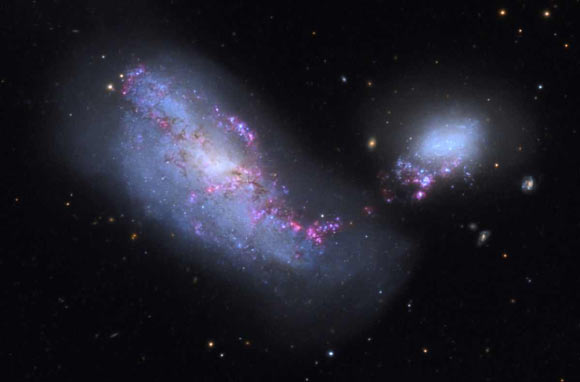In a study published in the Monthly Notices of the Royal Astronomical Society, Columbia University astronomer Sarah Pearson and co-authors show how gas expelled in the merger of two dwarf galaxies can linger across vast distances for billions of years, where it may eventually feed gas to more massive galaxies to make new stars.

This image shows low-mass galaxies NGC 4485 and NGC 4490. Image credit: Adam Block / Mount Lemmon SkyCenter / University of Arizona.
Home to millions of stars, dwarf galaxies are outshined by bigger galaxies with hundreds to thousands of times more stars.
But what dwarf galaxies lack in brightness, they make up for in their sheer abundance of star-making fuel.
The hydrogen gas swirling through dwarf galaxies like them are thought to play a key role in birthing new stars and other small galaxies.
To explore the star-making potential of dwarf galaxy pairs, Pearson and colleagues turned to two low-mass galaxies — NGC 4490 and NGC 4485 — approximately 24 million light-years away. This system is an isolated analog of the Magellanic Clouds and is surrounded by en enormous gas cloud.
Similar to the Large Magellanic Cloud, NGC 4490 is several times larger than its companion galaxy. But its isolated location allowed the team to simulate its eventual merger with NGC 4485 without interference from the Milky Way’s gravitational pull.
In their simulations, the astronomers watched the bigger galaxy, NGC 4490, peel off gas from its smaller sibling, a gravitational effect due to their lopsided difference in size.
As the pair circled ever closer to each other, the smaller galaxy’s tail of gas was swept farther and farther away, a finding that supports a study earlier this year that fingerprinted the gas streaming from the Magellanic Clouds into the Milky Way as belonging to the Small Magellanic Cloud.
Long after NGC 4490 collided with its smaller companion and merged into one in the researchers’ simulation, their gas footprint continue to expand.
In five billion years, they found, the pair’s gas tails would extend over a distance of 1 million light years, nearly twice its current length.
“After 5 billion years, 10% of the gas envelope still resides more than 260,000 light years from the merged remnant, suggesting it takes a very long time before all the gas falls back to the merged remnant,” Pearson said.
When the scientists compared their results to real-world observations of NGC 4490/4485 made by telescope, the results matched, indicating their model was accurate.
Their findings are also consistent with what astronomers know about the recycling of gas in the Universe.
As gas clouds grow more extended, the looser the gas becomes, thus making it easier for a bigger galaxy to come along and gobble it up.
The simulation suggests that this dispersal process has helped the Milky Way efficiently strip gas from the Small Magellanic Cloud, and that this sort of gas-transfer may be fairly common elsewhere in the Universe.
“Our study suggests that similar dwarf pairs exist out there. Because their gas is so extended, if they fall into something like the Milky Way, their gas is easily shed,” Pearson said.
_____
Sarah Pearson et al. Modeling the Baryon Cycle in Low Mass Galaxy Encounters: the Case of NGC 4490 & NGC 4485. MNRAS, published online August 3, 2018; doi: 10.1093/mnras/sty2052







